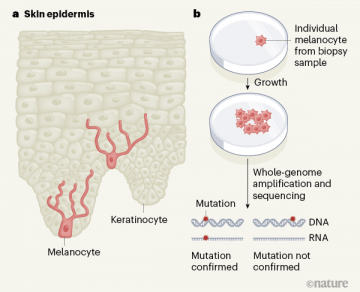Inigo Martincorena in Nature:
 Mutations occur in our cells throughout life. Although most mutations are harmless, they accumulate in number in our tissues as we age, and if they arise in key genes, they can alter cellular behaviour and set cells on a path towards cancer. There is also speculation that somatic mutations (those in non-reproductive tissues) might contribute to ageing and to diseases unrelated to cancer. However, technical difficulties in detecting the mutations present in a small number of cells, or even in single cells, have hampered research and limited progress in understanding the first steps in cancer development and the impact of somatic mutation on ageing and disease. Writing in Nature, Tang et al.1 report work that overcame some of these experimental limitations to explore somatic mutations and selection in individual melanocytes — the type of skin cell that can give rise to the cancer melanoma.
Mutations occur in our cells throughout life. Although most mutations are harmless, they accumulate in number in our tissues as we age, and if they arise in key genes, they can alter cellular behaviour and set cells on a path towards cancer. There is also speculation that somatic mutations (those in non-reproductive tissues) might contribute to ageing and to diseases unrelated to cancer. However, technical difficulties in detecting the mutations present in a small number of cells, or even in single cells, have hampered research and limited progress in understanding the first steps in cancer development and the impact of somatic mutation on ageing and disease. Writing in Nature, Tang et al.1 report work that overcame some of these experimental limitations to explore somatic mutations and selection in individual melanocytes — the type of skin cell that can give rise to the cancer melanoma.
The epidermis is the skin’s outermost layer. Just 0.1 millimetres thick, the epidermis is battered by mutation-promoting ultraviolet rays over a person’s lifetime, and is the origin of the vast majority of skin cancers.
To understand the extent of somatic mutation in a human tissue, and the origin of skin cancers, a previous study2 used DNA sequencing of small biopsies of normal epidermis. This revealed not only that mutations are common in normal cells, but also that mutations in cancer-promoting genes favour the growth of small groups of mutant cells (clones) that progressively colonize our skin as we age. However, the sequencing of biopsies of epidermis made up of thousands of cells mostly detected mutations in cells called keratinocytes, which comprise around 90% of all cells in the epidermis3. These are the cells from which the common, but typically treatable, non-melanoma skin cancers develop. The origins of melanoma, a rarer but more lethal form of skin cancer, lie in single cells scattered throughout the skin, called melanocytes (Fig. 1). These cells produce a pigment called melanin that gives skin its colour and protects it from the onslaught of sun damage.
More here.
